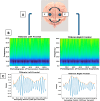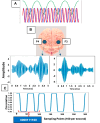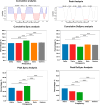Neural transmission in the wired brain, new insights into an encoding-decoding-based neuronal communication model
- PMID: 40819087
- PMCID: PMC12357859
- DOI: 10.1038/s41398-025-03506-0
Neural transmission in the wired brain, new insights into an encoding-decoding-based neuronal communication model
Abstract
Brain activity is known to be rife with oscillatory activity in different frequencies, which are suggested to be associated with intra-brain communication. However, the specific role of frequencies in neuronal information transfer is still an open question. To this end, we utilized EEG resting state recordings from 5 public datasets. Overall, data from 1668 participants, including people with MDD, ADHD, OCD, Parkinson's, Schizophrenia, and healthy controls aged 5-89, were part of the study. We conducted a running window of Spearman correlation between the two frontal hemispheres' Alpha envelopes. The results of this analysis revealed a unique pattern of correlation states alternating between fully synchronized and desynchronized several times per second, likely due to the interference pattern between two signals of slightly different frequencies, also named "Beating". Subsequent analysis showed this unique pattern in every pair of ipsilateral/contralateral, across frequencies, either in eyes closed or open, and across all ages, underscoring its inherent significance. Biomarker analysis revealed significantly lower synchronization and higher desynchronization for people older than 50 compared to younger ones and lower ADHD desynchronization compared to age-matched controls. Importantly, we propose a new brain communication model in which frequency modulation creates a binary message encoded and decoded by brain regions for information transfer. We suggest that the binary-like pattern allows the neural information to be coded according to certain physiological and biological rules known to both the sender and recipient. This digital-like scheme has the potential to be exploited in brain-computer interaction and applied technologies such as robotics.
© 2025. The Author(s).
Conflict of interest statement
Competing interests: The author declares no competing interests. Ethics approval and consent to participate: All methods were performed in accordance with the relevant guidelines and regulations. Our study utilizes data from five publicly available databases that do not contain identifiable patient-level data, and as such, informed consent from individual participants was not required.
Figures






Similar articles
-
Prescription of Controlled Substances: Benefits and Risks.2025 Jul 6. In: StatPearls [Internet]. Treasure Island (FL): StatPearls Publishing; 2025 Jan–. 2025 Jul 6. In: StatPearls [Internet]. Treasure Island (FL): StatPearls Publishing; 2025 Jan–. PMID: 30726003 Free Books & Documents.
-
Short-Term Memory Impairment.2024 Jun 8. In: StatPearls [Internet]. Treasure Island (FL): StatPearls Publishing; 2025 Jan–. 2024 Jun 8. In: StatPearls [Internet]. Treasure Island (FL): StatPearls Publishing; 2025 Jan–. PMID: 31424720 Free Books & Documents.
-
Systemic treatments for metastatic cutaneous melanoma.Cochrane Database Syst Rev. 2018 Feb 6;2(2):CD011123. doi: 10.1002/14651858.CD011123.pub2. Cochrane Database Syst Rev. 2018. PMID: 29405038 Free PMC article.
-
Systemic pharmacological treatments for chronic plaque psoriasis: a network meta-analysis.Cochrane Database Syst Rev. 2021 Apr 19;4(4):CD011535. doi: 10.1002/14651858.CD011535.pub4. Cochrane Database Syst Rev. 2021. Update in: Cochrane Database Syst Rev. 2022 May 23;5:CD011535. doi: 10.1002/14651858.CD011535.pub5. PMID: 33871055 Free PMC article. Updated.
-
Methylphenidate for children and adolescents with autism spectrum disorder.Cochrane Database Syst Rev. 2017 Nov 21;11(11):CD011144. doi: 10.1002/14651858.CD011144.pub2. Cochrane Database Syst Rev. 2017. PMID: 29159857 Free PMC article.
References
-
- Koch C, Massimini M, Boly M, Tononi G. Neural correlates of consciousness: progress and problems. Nat Rev Neurosci. 2016;17:307–21. - PubMed
-
- Mushtaq F, Welke D, Gallagher A, Pavlov YG, Kouara L, Bosch-Bayard J, et al. One hundred years of EEG for brain and behaviour research. Nat Hum Behav. 2024;8:1437–43. - PubMed
MeSH terms
Grants and funding
LinkOut - more resources
Full Text Sources

